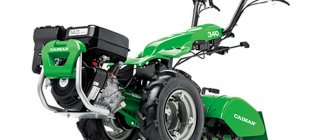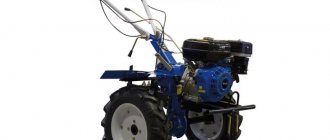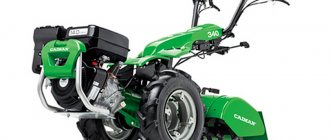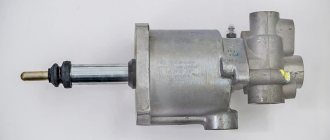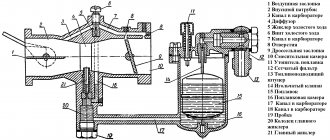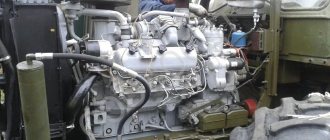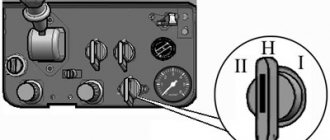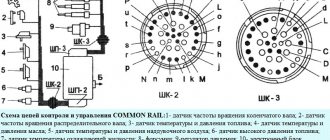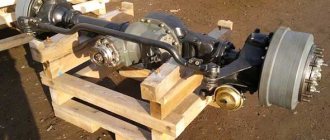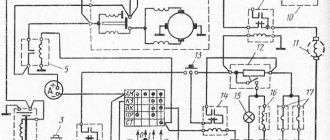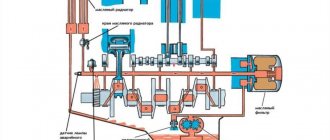The clutch on the T-150 and T-150K tractors is responsible for smooth starting. The serviceability of the module and its correct adjustment play an important role in this. How the clutch on the wheeled and tracked T-150 works, what parts it consists of, how to replace spare parts and make adjustments - we will answer these and other questions in this article.
- Checking clutch operation
Repair and possible malfunctions of the T-150K tractor gearbox
The T150 tractor is equipped with a mechanical gearbox equipped with hydraulic control.
This solution is used to ensure gear shifting on the go. There is no power loss in this case. At the same time, the tractor’s performance increases, fuel is saved (which is especially important for commercial vehicles), and the driver’s work is significantly easier. To ensure the movement of the tractor at particularly low speeds, there is a speed reducer in the gearbox part. When using it, it is possible to perform certain types of work particularly efficiently, since the speed is reduced and at the same time the traction force is significantly increased.
Gearbox of the T-150 tractor
Mode switching diagram
This box has three ranges for forward movement (slow, working, transport) and one for reverse. Each range has four gears (the same number as hydraulic clutches on the secondary shaft). To switch ranges, you need to stop the tractor and engage the gears, which transmit rotation from the input shaft only to the intermediate shaft.
Gearbox device
In the T150 gearbox, unlike similar units in other tractors, there are two identical shafts with brakes (not one) - for the left and right caterpillar movers separately. This allows you not only to change the speed and traction force, but also to provide turns of different radii. While both secondary shafts are moving at the same frequency, straight motion occurs. When the tractor turns, the shafts begin to rotate at different frequencies, or one of them brakes. Here is a diagram of the 150k gearbox with designations of all the main parts, including the power take-off shaft driven from the box, which is mandatory for equipment of this type - because it ensures the operation of various attachments. The mechanisms by which the rows are switched, as well as the power take-off shafts and pumps are turned on, are located on the housing covers.
Be sure to read: MTZ 82 filling tanks: how much oil is in the engine
The gearbox lever is loosely placed on an axle installed in the housing. It is connected to the brake pedal using a rod.
Checkpoint diagram
Checking and adjusting the clutch of tractors T-150 and T-150K
When servicing the tractor, it is necessary to check the performance of the clutch: determine the cleanliness of disengagement and smooth engagement of the clutch, the slipping of its disks and their oiliness. Check and adjust the gap between the release lever ring and the release bearing race, as well as the stroke of the pressure plate.
The gap between the release bearing stop and ring 14 should be 3.5...4 mm. It corresponds to a free play of the clutch pedal of 30...40 mm. This gap is adjusted by changing the length of the rod 33. If the adjustment reserve with the rod is exhausted (the tap 9 rests against the shoulder of the bracket 7), then you need to unscrew each adjusting nut 10 by one and a half turns through the hatch of the clutch housing. After this, by changing the length of the rod 33, the gap is adjusted.
Then check the contact of the end surface of the ring 14 with the end of the thrust bearing. The distortion of the ring is eliminated by turning the nuts 10 to the required number of edges.
The gap between the ends of the brake pad and nut 38 is adjusted with this nut by 3...3.5 mm when the clutch is completely disengaged. With this regulation, timely activation and release of the clutch brake is achieved.
Periodic Maintenance No. 3
1. Inspect and wash the tractor.
2. Conduct general diagnostics of the main units of the T-150 tractor. At the same time, determine the degree of wear and residual life of the liner-piston group, gas distribution mechanism, engine crankshaft bearings and power transmission units. If they do not need repair, carry out the work listed below. For the new T-150 tractor, diagnostics are carried out after 1920 operating hours,
3. Check and adjust if necessary:
- clearances between engine valves and rocker arms;
- tensioning fan, generator and compressor drive belts;
- the gap between the release bearing cup and the clutch release lever ring; clutch shaft brake; clutch coupling of the P-350 starting motor gearbox; brakes and their drive;
- bearings: drive gear of the main gears of the rear and front axles; final drives; intermediate support for rear axle drive cardans (T-150K);
- pressure regulator of the pneumatic system (with flushing of all parts);
- hydraulic system units; tire pressure (T-150K);
- track roller bearings (T-150); guide wheels (T-150);
- position the track tensioner intermediate link, eliminating the gap between its stop and the stop on the frame; track tension (T-150).
4. Carry out maintenance of air cleaners: wash the cassette and deflector of the main engine air cleaner, moisten the cassette in oil, clean the inner surface of the cyclones with a brush; Wash the filter element of the starting engine air cleaner, wring it out, and then soak it in oil and wring it out again.
5. Carry out maintenance of the power system:
- replace the filter elements of the 2TF-3 filter of the first stage and the element of the filter-bracket of the second stage of fine fuel purification with flushing of cavities; wash the fuel coarse filter; check and, if necessary, adjust the fuel pump and injectors (on a stand), followed by checking the fuel injection timing on the engine, as well as the correct connection of the high-pressure pipes to the pump fittings;
- drain the sediment from the fuel tank and remove air from the fuel system;
- clean and rinse the main engine fuel tank cap and filter;
- Wash the strainer of the fuel supply fitting of the carburetor and the sump of the fuel tank of the starting engine.
6. Carry out maintenance of electrical equipment:
- clean the top surface of the battery and clean the ventilation holes in the plugs;
- clean and lubricate oxidized output terminals and wire tips;
- check the electrolyte level in each battery and add distilled water if necessary;
- check the battery charge level and, if necessary, recharge or replace it with a charged one;
- check the condition of the electrical wiring, isolate damaged areas;
- check the accuracy of the readings of control devices;
- check and, if necessary, adjust the relay regulator;
- check the smoothness and ease of rotation of the generator armature;
- check the gap between the spark plug electrodes and the contacts of the magneto breaker and, if necessary, adjust, moisten the felt wick with oil.
Repair of tractor T-150 | Books and manuals
The development of the T-150K tractor in the 20th century became a real breakthrough in tractor construction. The first tractor of this model was produced at the Kharkov Tractor Plant. Creating this model required a large amount of resources, both physical and mental. After all, very qualified engineers worked on the creation, the leader among them was Boris Pavlovich Kashuba. Development of the project began with the name “T-150”. As a result, in 1971 the first T-150K tractor rolled off the assembly line. Moreover, the plant produced a very small batch - only 500 pieces.
The T-150 tractor, produced at the plant in Kharkov, belongs to the class of agricultural machinery. Available in two versions: wheeled and tracked. They have a number of differences in the mechanics of movement, chassis system, control and gearboxes.
The first wheeled one was designed in 1967. The T-125, which has a unique individual design, was taken as the basis for its creation. Almost from the moment of release, the model became very popular among consumers.
12 years after its release, it underwent international testing in Nebraska, where it confirmed its high quality and reliability. For more than forty years, the unit continues to be modernized and improved, and more and more advanced models are produced.
The tractor has found wide application in agricultural and municipal needs. Can be used both during plowing or sowing and during soil cultivation and harvesting. It will also be indispensable during transportation due to the use of various types of semi-trailers, fastenings, trailers and cables. Considering the fact that the model has all driving wheels, it becomes mobile enough to participate in road construction repair work. Belongs to the third traction class.
Repair of the T-150 tractor: Available modifications
- In industry, the most widely used device was the T-158 version;
- To perform tasks in confined spaces T-155;
- The skidding T-157 is most in demand in forestry;
- For loading/unloading T-156;
- When repairing the roadway or laying pipes, the T-150KD, equipped with bulldozer equipment.
Advantages and disadvantages of the T-150
The advantages of the tractor are described in numerous reviews from owners and machine operators with experience in operating this agricultural machine. These advantages include:
- low ground pressure with high weight, which improves agricultural production;
- productivity when working with additional equipment due to the use of increased speed;
- the presence of two main gears reduces the load on transmission components, which also increases durability;
- maintainability due to the availability of spare parts, including used ones, which are purchased through advertisements for the sale of a tractor;
- year-round use by converting it into a bulldozer to clear rural roads of snow;
- reliable design allows repairs to be carried out in rural workshops;
- a large number of available trailed, semi-mounted and mounted equipment;
- low fuel consumption;
- decent working conditions for machine operators.
Among the shortcomings are:
- increased wear of tracks due to their own weight;
- movement speed;
- lack of a mechanism for cooling the working fluid in the hydraulic system;
- unreliable gearbox;
- Difficulty starting the engine in winter.
Fuel consumption t 150k
The fuel consumption of the t 150k tractor varies depending on the task being performed. Under increased load, fuel consumption can increase by 50%. It is worth noting that this T 150 tractor, unlike its foreign competitors, is not picky about the quality of diesel fuel. And this is its big advantage.
Characteristics t 150k
| Oil in drive axles, l | 30 |
| Oil in the hydraulic system of the attachment, l | 38 |
| Engine oil, l | 25 |
| Gearbox oil, l | 18 |
| Steering oil, l | 40 |
| PTO gearbox oil, l | 6 |
| Coolant, l | 30 |
| Coolant type | antifreeze or water |
| Fuel, l | 330 |
| Specific fuel consumption at engine operating power, g/kWh. (g./hp.h.) no more | 248 (182) |
| Specific fuel consumption at maximum power at PTO, g/kWh. (g./hp.h.) | 258 (190) |
How to install a dispenser pump on the T-150?
Steering conversion
The steering system consists of a hydraulic steering system and a mechanical part. Using hydraulics (T-150 rotation hydraulic cylinders), the semi-frames are rotated. Mechanics are responsible for rotation and feedback. To reduce loads during turns and increase vehicle controllability when driving on uneven roads, an additional installation of a dispenser is required on the T-150.
The conversion kit includes:
- Dispenser pump MRG-500 (working volume 500 cm^3) without a valve or dispenser D-500 (made in Bulgaria) with a safety valve, then valve 151.40.039-4 is not needed in the kit (highlighted in red in the list)
- Steering column for dispenser 151.40.052 1 pc.;
- Flow valve 151.40.039-4 1 pc.;
- Hydraulic oil drain pipe 151K.40.031 1 pc.
- Drain pipe 151.40.029-9 1 pc.;
- Hydraulic pipe 151.40.060-1 2 pcs.;
- Pipe 151.40.063-9 1 pc.;
- Pipe 150K.40.031 1 pc.;
- High pressure hose 150.61.020-01 1 pc.;
- High pressure hose 150.61.020-02 2 pcs.;
- Bolt 88.35.019 for fastening the dispenser pump (BNP-M 10.6G*40.35) 4 pcs.;
- Bolt 88.35.019 for installing the steering column (BNP-M 10.6G*65.35) 3 pcs.;
- Washer ShNG-1065 G20 4 pcs.;
Can you please tell me how to properly adjust the brakes?
Can you please tell me how to properly adjust the brakes?
If I understand correctly, we are talking about the brakes on the box. This is the first time I hear that there is some kind of adjustment.
As far as I know the brake can be changed, it is not adjustable
Just change the brakes and that's it...
Lech, if only they were)) someone said something to tighten it then back it out three turns at a time, I still don’t understand anything, I think I’ll ask if someone knows exactly how to do it correctly
Antoha, damn, your brake pads need to be fitted.
Lech, no, Lech I can set the brake pads myself, my parking brake stopped holding, the slope rolls a little as if I were driving myself, and when you turn it on there’s a strange creaking sound, etc.
Antoha, running and after stopping? Long lever forward and slightly up until it stops? Are the brakes fucked up...?
Antoha, the booster doesn’t stop, but how does it switch modes?
Lech, the mode turns on perfectly, rarely growls.
Antoha, that means the cylinder on the gearshift lever is fucking your head...
Antoha, or the lever itself from below under the cabin where the finger was broken...
Antoha, open the hatch and look, it doesn’t turn on the “n” for you...
Antoha, “brakes”, should I have written brakes like that...? I don’t remember exactly, last year I let it down, but I unscrew the inner covers on the brake drums so that the pads can be seen, and then I tighten them with ratchets and look, or when I remove the wheel, I turn the hub slowly and tighten it, as the hub spins a little tight , All,. But since new, yes, on Kirovs you tighten it all the way and release it until three clicks.
This is for t 150 so
I completely changed this crap and the oil under the cylinder started leaking like a stream
Guys, don’t consider this an advertisement, if anyone needs new checkpoints, bridges and other components on Kirovtsi, they do it here, contact us, it’s been checked personally!
How to change the clutch bearing yourself?
When replacing any part of the clutch mechanism, it is recommended to install a new release device. Its price is low, so you shouldn’t skimp on buying a part, even if it has not reached its intended service life. The work of replacing the clutch release bearing is not too complicated, so you can do it yourself if you have the necessary tools and some repair skills. To install a new part, you need to perform the following steps sequentially:
- Remove the gearbox and disconnect the pressure fork from the clutch.
- Remove the bearing from the transmission input shaft.
- Remove the spring clip from the piece of the outer body of the part.
- Check the new part for ease of rotation and presence of lubrication.
- Install the spring retainer onto the coupling.
- Place the assembly onto the gearbox shaft.
- Connect the plug to the coin and secure with a spring.
- Reinstall the gearbox.
After assembly is completed, adjust the drive if necessary . To check the operation of the replaced unit, you need to start the engine and squeeze the clutch. If no extraneous sounds are heard, it means the work was done correctly.
Replacing a unit at a service station should be carried out in cases where there is no confidence in the quality of the operation with your own hands.
Replacing the clutch on MTZ tractors
Adjusting and replacing the clutch at MTZ Belarus
Replacementfrom 25,000All work with the engine removed2,500| Works | price, rub. |
| Adjustment | 1 500 |
| Remove/install the flywheel with the engine removed | 1 500 |
| Replace the flywheel crown with the engine removed | 1 200 |
We carry out replacement of any components and complete repairs of MTZ 82,80,320,920,1221 and other models. We have the ability to carry out all work on site. Mobile teams are staffed with experienced specialists and all the necessary equipment.
MTZ tractor clutch
The clutch disc is a very important part of the transmission of any modern tractor. For example, if the spring pressure in the disk weakens, over time the clutch will begin to slip.
Malfunctions of the Belarus clutch mechanism:
The main reason for clutch failure is disc wear. When using equipment for a long time with a worn clutch, the disc begins to warp. The friction linings of parts wear out over time, and rivet heads may weaken. This may cause the pressure plate to become overheated.
Despite this, with the necessary care, both the flywheel and the disk can last a long time. An important point is to recognize the first signs of a possible breakdown and remove them. Clutch adjustment for Belarus MTZ 82, 80, 320, 311 should be carried out according to the parameters of a specific model. If there is an oil leak through the shaft seal of a vehicle engine or gearbox, you must use the services of a service center. In addition, it is very difficult to eliminate oil leakage from internal oil seals on your own - this procedure requires rolling out the tractor.
Important spare parts for T-150
As with any equipment, some parts also fail in the T-150. It is important to find the cause of the malfunction in time and eliminate it. Anything can fail - from engine pistons to transmission elements or clutch parts. Let's look at the latter in more detail. After all, it is the clutch that is responsible for driving the tractor, selecting speeds and protecting against overloads. The clutch in the T-150 serves to briefly disengage and smoothly connect the engine and transmission. And while driving, it protects the transmission from heavy loads through the transmission of torque from the engine to the gearbox. Accordingly, it is the clutch discs that are responsible for the long-term operation of many other tractor parts.
vote
Article rating
